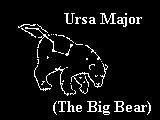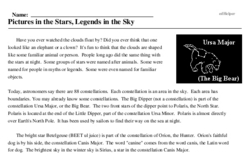Pictures in the Stars, Legends in the Sky
Have you ever watched the clouds float by? Did you ever think that one looked like an elephant or a clown? It's fun to think that the clouds are shaped like some familiar animal or person. People long ago did the same thing with the stars at night. Some groups of stars were named after animals. Some were named for people in myths or legends. Some were even named for familiar objects.
Today, astronomers say there are 88 constellations. Each constellation is an area in the sky. Each area has boundaries. You may already know some constellations. The Big Dipper (not a constellation) is part of the constellation Ursa Major, or the Big Bear. The two front stars of the dipper point to Polaris, the North Star. Polaris is located at the end of the Little Dipper, part of the constellation Ursa Minor. Polaris is almost directly over Earth's North Pole. It has been used by sailors to find their way on the sea at night.
The bright star Betelgeuse (BEET ul juice) is part of the constellation of Orion, the Hunter. Orion's faithful dog is by his side, the constellation Canis Major. The word "canine" comes from the word canis, the Latin word for dog. The brightest sky in the winter sky is Sirius, a star in the constellation Canis Major.
Orion and Canis Major can be seen in the evening winter sky. During other seasons, they are not visible in North America. All the constellations look like they move because the Earth is moving.




